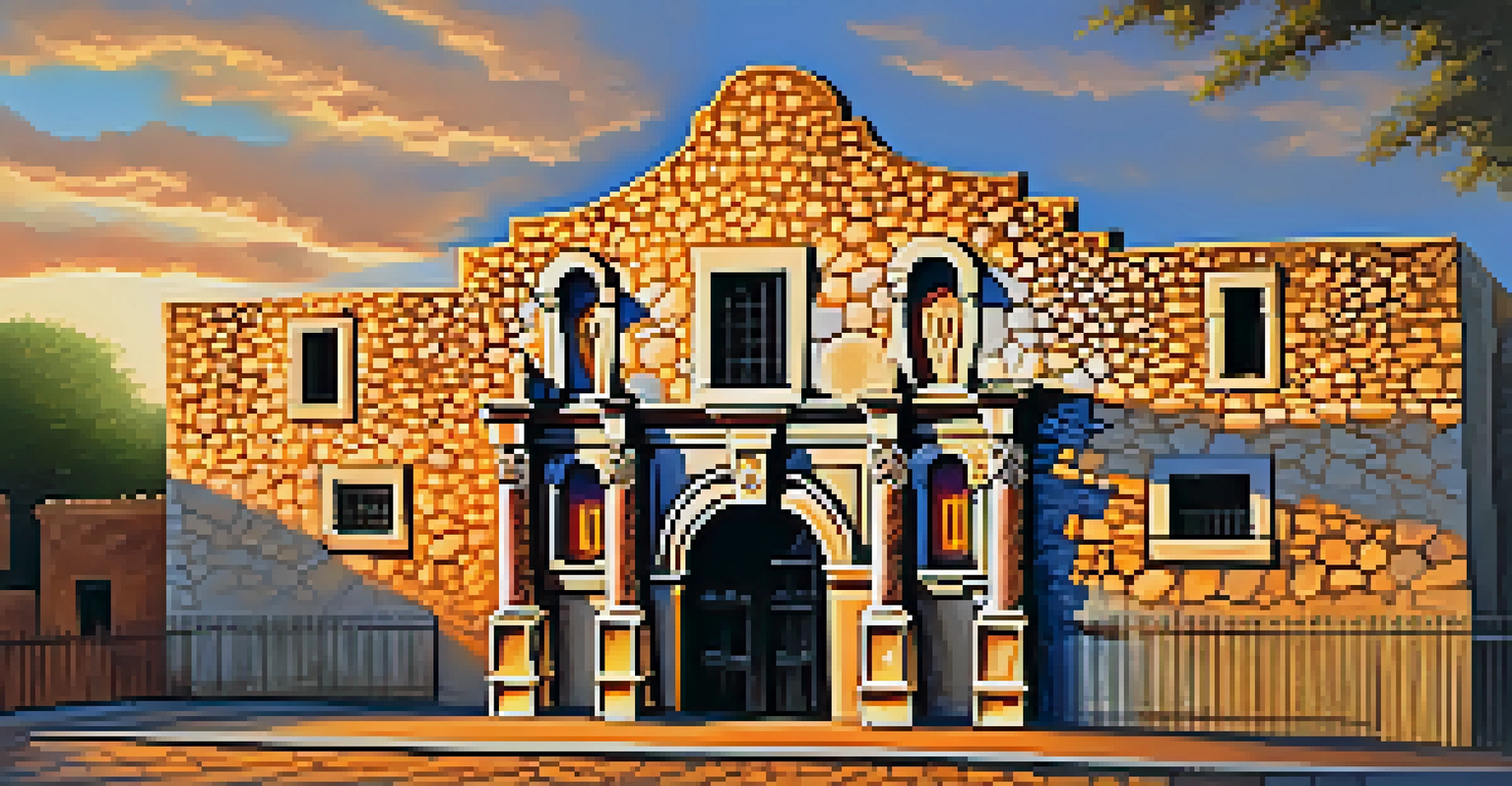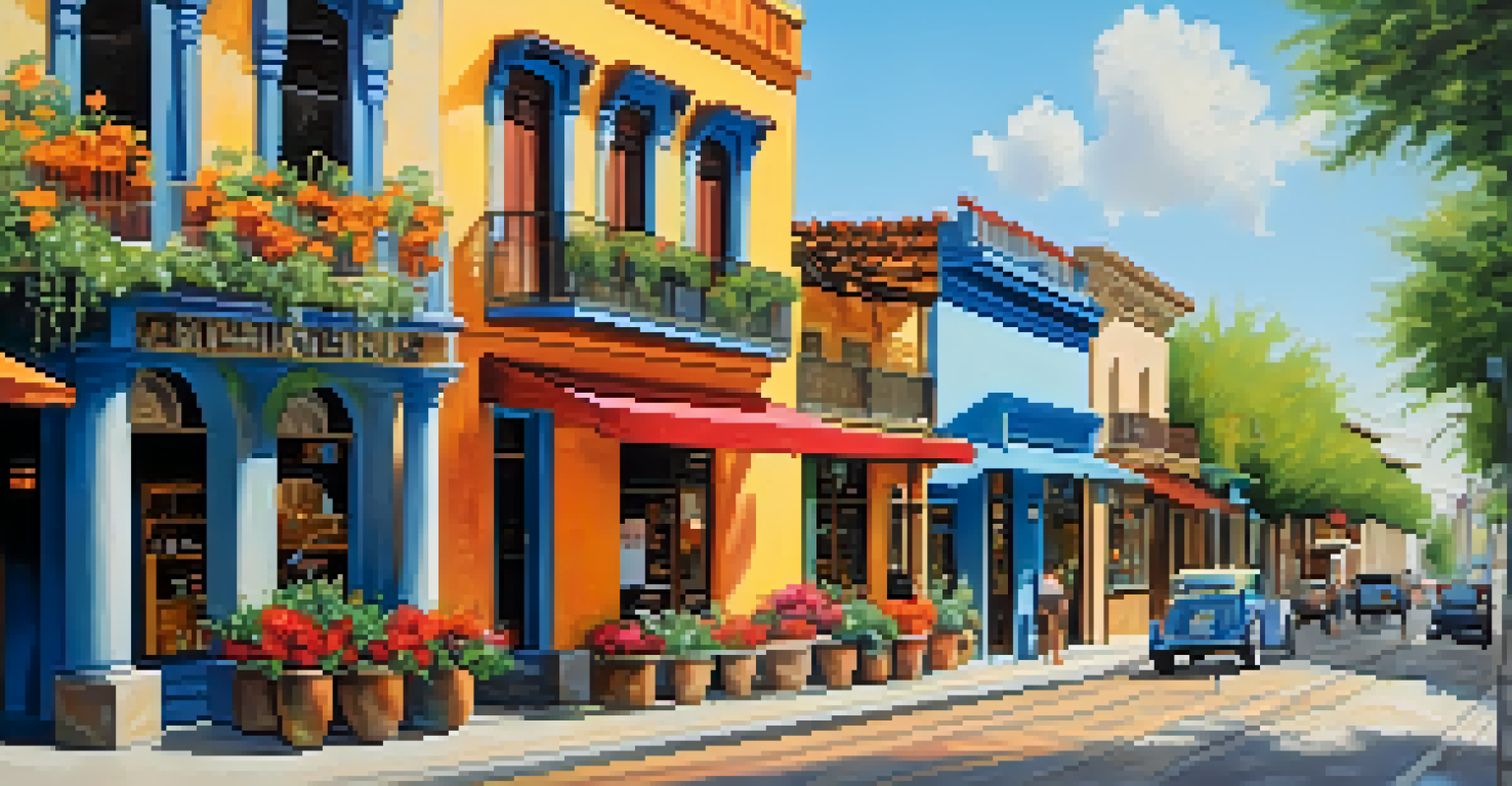Spanish Colonial Architecture in San Antonio: A Historical Tour

Introduction to Spanish Colonial Architecture
Spanish colonial architecture is a distinct style that emerged in the Americas during the 16th to 19th centuries. Characterized by its simple forms and rich details, this architectural style reflects the cultural fusion of Spanish settlers and indigenous people. In San Antonio, this style not only defines the city's skyline but also narrates a compelling story of its historical significance and cultural heritage.
Architecture is the learned game, correct and magnificent, of forms assembled in the light.
The architecture often features thick adobe walls, red-tiled roofs, and intricate wrought-iron details, making it visually appealing and functional for the region's climate. As you stroll through San Antonio, you'll notice how these elements create a sense of place that transports you back in time. This connection to the past is one of the many reasons why visitors are drawn to explore this architectural marvel.
Understanding Spanish colonial architecture in San Antonio offers insights into the city's history and the ways in which different cultures have intertwined. It’s more than just buildings; it’s about the stories they hold and the experiences they represent. Let's embark on a historical tour to uncover the beauty and significance of these structures.
The Alamo: A Symbol of Resilience
No discussion of Spanish colonial architecture in San Antonio would be complete without mentioning The Alamo. Originally built as a mission in 1718, it later became a military outpost and a symbol of Texas independence. The iconic structure features a unique blend of Spanish colonial and mission-style architecture, showcasing thick stone walls and arched doorways that have stood the test of time.

The Alamo's role in Texas history adds layers of significance to its architectural beauty. As you explore its grounds, you can almost feel the weight of the historical events that took place here. This deep connection between architecture and history makes The Alamo not only a tourist attraction but also a profound symbol of resilience and courage.
Cultural Fusion in Architecture
Spanish colonial architecture in San Antonio showcases a unique blend of Spanish and indigenous influences, reflecting the city's rich cultural heritage.
Visitors often find themselves captivated by the stories of those who fought for their freedom within its walls. The Alamo serves as a reminder of the enduring spirit of San Antonio and the importance of preserving its historical landmarks. A visit to The Alamo is not just about admiring its architecture; it's about honoring the past.
Mission San José: Architectural Elegance
Mission San José, founded in 1720, is one of the most beautiful examples of Spanish colonial architecture in San Antonio. Known as the 'Queen of the Missions,' it showcases stunning features like its impressive stone façade, ornate altars, and intricately carved wooden doors. The mission's design reflects both the religious and cultural aspirations of the Spanish settlers.
We shape our buildings; thereafter they shape us.
What sets Mission San José apart is its sweeping courtyard and the surrounding structures that create a harmonious environment. Visitors can wander through the lush gardens and imagine life as it was for the missionaries and indigenous people who once lived and worked here. The mission stands as a testament to the blending of cultures, evident in both the architecture and the community it fostered.
Today, Mission San José is a UNESCO World Heritage Site, drawing visitors from around the globe. Its preserved beauty offers a glimpse into the past while inviting guests to appreciate the artistry of Spanish colonial architecture. A tour of Mission San José is an enriching experience that combines history, culture, and architectural elegance.
La Villita: A Living History District
La Villita is San Antonio's oldest neighborhood, where Spanish colonial architecture is beautifully preserved. This historic district features charming adobe buildings that have been transformed into shops, galleries, and restaurants, creating a vibrant atmosphere. As you walk the cobblestone streets, you'll be surrounded by the rich history and culture that define the area.
The buildings in La Villita showcase the simplicity and functionality of Spanish colonial design, with their earthy tones and adobe plaster finishes. This architectural style not only reflects the past but also serves as a canvas for modern artisans and entrepreneurs. The contrast between the historic structures and contemporary businesses illustrates how San Antonio honors its heritage while embracing the future.
Historic Significance of The Alamo
The Alamo stands as a powerful symbol of Texas independence and resilience, intertwining architectural beauty with profound historical narratives.
Visiting La Villita feels like stepping into a living museum, where history comes alive through art, food, and community events. It's a great place to immerse yourself in the local culture while appreciating the beauty of Spanish colonial architecture. Whether you’re shopping for unique souvenirs or enjoying a meal, La Villita offers an unforgettable experience.
Spanish Governor's Palace: A Glimpse into the Past
The Spanish Governor's Palace is another remarkable example of Spanish colonial architecture in San Antonio. Built in the 18th century, this historic building served as the residence for Spanish governors and reflects the opulence of the time. Its lavish interiors and elegant courtyard transport visitors to an era of grandeur and political significance.
The palace features stunning architectural elements such as arched doorways, decorative tile work, and lush gardens that enhance its charm. Each room tells a story, showcasing the lifestyle of the Spanish elite and their interactions with local communities. Exploring the Spanish Governor's Palace allows you to appreciate the intricate details that define this unique architectural style.
Today, the palace serves as a museum, offering guided tours that delve into its rich history. Visitors can learn about the role of the governors and the impact of Spanish rule on San Antonio's development. A stop at the Spanish Governor's Palace is essential for anyone looking to understand the cultural tapestry of the city.
The Missions: A UNESCO World Heritage Site
The San Antonio Missions, including Mission San José, Mission Concepción, Mission San Juan, and Mission Espada, are collectively recognized as a UNESCO World Heritage Site. These missions are not only architectural gems but also crucial to understanding the spread of Spanish culture in North America. Their preservation underscores the importance of safeguarding our historical landmarks for future generations.
Each mission boasts distinctive features and architectural elements that reflect the unique cultural influences of their time. For example, Mission Concepción is noted for its beautiful frescoes, while Mission Espada showcases stunning aqueducts. Together, they provide a comprehensive picture of Spanish colonial life and the interactions between settlers and indigenous populations.
Preservation Efforts for Legacy
Community-driven preservation initiatives are crucial for maintaining the integrity and history of San Antonio's Spanish colonial architectural treasures.
Visiting the missions offers a deeper appreciation for the artistry and craftsmanship involved in their construction. As you explore these sites, you can witness the enduring legacy of Spanish colonial architecture and its significant role in shaping the identity of San Antonio. It's a journey that connects the past with the present.
Preserving the Legacy of Spanish Colonial Architecture
The preservation of Spanish colonial architecture in San Antonio is vital for maintaining the city's historical integrity. Organizations and local governments work diligently to restore and protect these significant structures from the ravages of time. This commitment to preservation ensures that future generations can experience the beauty and history of these architectural treasures.
Community involvement plays a crucial role in these preservation efforts. Local residents and historians often collaborate to raise awareness and funds for restoration projects. Their passion for safeguarding the city's heritage highlights the importance of collective responsibility in maintaining cultural landmarks.

As you explore San Antonio's architectural landscape, consider the work that goes into preserving these sites. Understanding the challenges and triumphs of preservation adds another layer of appreciation for the beauty around you. With continued efforts, San Antonio's Spanish colonial architecture will remain a vibrant part of the city's identity.
Conclusion: A Journey Through Time
Exploring Spanish colonial architecture in San Antonio is like taking a journey through time. Each building and structure tells a story, reflecting the rich tapestry of history, culture, and artistry that defines the city. From the iconic Alamo to the serene Missions, these architectural gems captivate the imagination and inspire a sense of wonder.
As you walk through the streets of San Antonio, take a moment to appreciate the intricate details and historical significance of the buildings around you. They are more than just structures; they are symbols of resilience, community, and cultural fusion. This architectural journey not only enriches your understanding of San Antonio but also deepens your connection to its vibrant history.
In conclusion, whether you're a history buff, architecture enthusiast, or simply a curious traveler, San Antonio's Spanish colonial architecture offers something for everyone. So grab your walking shoes and get ready to discover the beauty and stories waiting to be uncovered in this historic city.